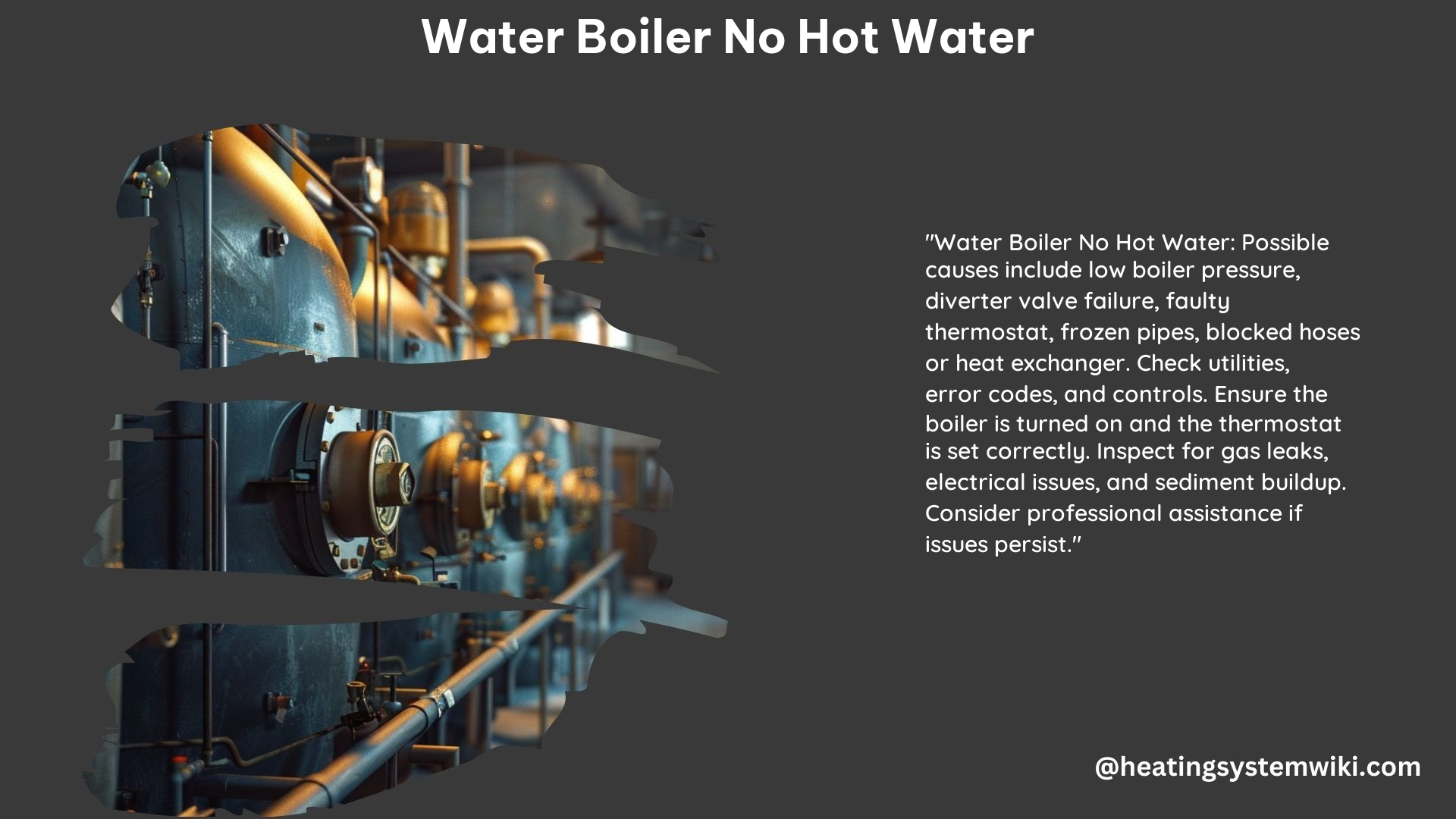If your water boiler is not providing hot water, it can be a frustrating and concerning issue. However, with the right troubleshooting steps and technical knowledge, you can often resolve the problem yourself. This comprehensive guide will walk you through the common causes of a water boiler not heating water and provide detailed solutions to get your hot water back up and running.
Causes of Water Boiler No Hot Water
1. Gas Leak
A gas line leak can prevent your water heater from functioning properly. Inspect all gas line connections for any signs of leaks, such as the smell of gas or hissing sounds. If you suspect a gas leak, immediately shut off the main gas valve and call a professional gas technician to address the issue.
2. Electric Water Heater Malfunction
Both gas and electric water heaters can experience malfunctions that lead to a lack of hot water. Check the thermostat on your electric water heater to ensure it is set to the correct heating mode and temperature. The thermostat should be set between 120°F (49°C) and 140°F (60°C) for optimal performance.
3. Leaking Tank
A leaking water heater tank can cause water to accumulate around the base of the unit, indicating a problem with the tank itself. Inspect the tank for any visible cracks or signs of corrosion, and consider replacing the water heater if the tank is beyond repair.
4. Pilot Light Issues
If your water heater has a pilot light, a faulty or extinguished pilot light can prevent the boiler from heating the water. Relight the pilot light according to the manufacturer’s instructions, and ensure that the pilot light remains lit.
5. Thermostat Issues
Ensure that the thermostat on your water heater is set correctly and functioning properly. The thermostat should be set to the desired temperature, typically between 120°F (49°C) and 140°F (60°C). If the thermostat is malfunctioning, it may need to be repaired or replaced.
6. Frozen Pipes
Frozen pipes can prevent hot water from circulating through your plumbing system. Check for frozen pipes, especially in areas with limited insulation, and take steps to thaw the pipes if necessary.
7. Diverter Valve Failure
The diverter valve is responsible for directing the flow of hot water to the appropriate outlets. If the diverter valve is faulty, it can prevent hot water from reaching the desired taps or fixtures. Inspect the diverter valve and replace it if necessary.
8. Low Boiler Pressure
Insufficient boiler pressure can prevent the water heater from producing hot water. Typically, the boiler pressure should be between 12 and 15 psi. Check the pressure gauge and adjust the pressure if needed.
9. Faulty Heating Elements
In electric water heaters, the heating elements can become faulty or accumulate sediment, reducing the boiler’s ability to heat the water. Inspect the heating elements and replace them if necessary.
Solutions for Water Boiler No Hot Water

-
Check Utilities: Ensure that you have a reliable electricity and gas supply to the water boiler.
-
Inspect Controls: Carefully examine the controls on your water boiler, including the thermostat, pressure gauge, and any other relevant components, to ensure they are set correctly and functioning properly.
-
Check Error Codes: If your water boiler has a digital display, check for any error codes or fault codes that may provide clues about the underlying issue.
-
Reset the Boiler: If the water boiler is not responding to your troubleshooting efforts, try resetting the unit according to the manufacturer’s instructions.
-
Call a Professional: If you are unsure about how to diagnose or repair the issue, it is best to call a professional plumber or HVAC technician who can properly assess and address the problem.
Technical Specifications
Boiler Pressure
Typically, the boiler pressure should be between 12 and 15 psi for optimal performance. If the pressure is too low, it can prevent the water heater from producing hot water.
Thermostat Settings
The thermostat on your water heater should be set between 120°F (49°C) and 140°F (60°C) for safe and efficient operation. Temperatures above 140°F (60°C) can pose a scalding risk.
Heating Elements
In electric water heaters, the heating elements can accumulate sediment over time, reducing their efficiency. Regularly flushing the boiler and inspecting the heating elements can help maintain optimal performance.
References
- ARS. (2022). 9 Reasons There is No Hot Water in Your House & How to Fix It. Retrieved from https://www.ars.com/blog/no-hot-water-in-house
- Reddit. (2022). No hot water and heat isn’t working. Retrieved from https://www.reddit.com/r/homeowners/comments/zy5up2/no_hot_water_and_heat_isnt_working/
- Boiler Central. (n.d.). No Hot Water: Common Causes & How To Fix It. Retrieved from https://www.boilercentral.com/troubleshooting/no-hot-water-coming-from-your-boiler/
- Dereton33. (2013). No hot water from your boiler? What to look for and how to fix it. Retrieved from https://www.youtube.com/watch?v=PhXKd10wZAM
- Howell Mechanical. (n.d.). Why Is My Boiler Not Heating Water? Retrieved from https://howellmechanical.com/blog/why-is-my-boiler-not-heating-water/
